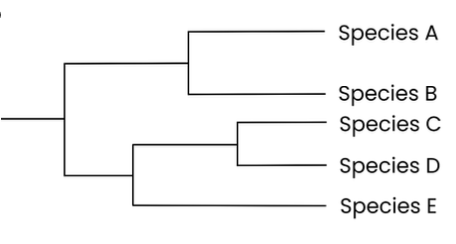4.5 Species and taxonomy
1/13
There's no tags or description
Looks like no tags are added yet.
Name | Mastery | Learn | Test | Matching | Spaced |
|---|
No study sessions yet.
14 Terms
What is a species?
A group of organisms that can (interbreed to) produce fertile offspring
Suggest why 2 different species are unable to produce fertile offspring
Different species have different chromosome numbers → offspring may have odd chromosome number
So homologous pairs cannot form → meiosis cannot occur to produce gametes
Describe 5 ways in which Courtship Behaviour ensures successful reproduction
Recognising members of the same species
Identifying a mate that is capable of breeding
Forming a pair bond
Synchronisation of mating
Become able to breed
Explain Recognising members of the same species
To ensure that mating occurs only between members of the same species
Only members of the same species will produce fertile offspring
This prevents interbreeding, making reproduction more successful
Due to this specificity, it can be used when classifying organisms
Explain Identifying a mate that is capable of breeding
Both partners need to be sexually mature, fertile and receptive to mating
Explain Forming a pair bond
Leading to successful mating and raising of offspring
Stable family
Explain Synchronisation of mating
Ensuring that mating occurs when there’s the max probability of the sperm and egg meeting
Explain Becoming able to breed
by bringing a member of the opposite sex into a physiological state that allows breeding to occur
Describe a phylogenetic classification system
Species (attempted to be) arranged into groups, called taxa, based
on their evolutionary origins (common ancestors) and relationships
Uses a hierarchy:
○ Smaller groups are placed within larger groups
○ No overlap between groups
Name the taxa in the hierarchy of classification
1. Domain (largest / broadest) - Bacteria, Archaea and Eukarya
2. Kingdom
3. Phylum
4. Class
5. Order
6. Family
7. Genus
8. Species (smallest)
How is each species universally identified?
A binomial consisting of the name of its genus and species, eg. Homo sapiens
Suggest an advantage of binomial naming
Universal so no confusion as many organisms have more than one common name
How can phylogenetic trees be interpreted?
● Branch point = common ancestor
● Branch = evolutionary path
● If two species have a more recent common
ancestor, they are more closely related (eg. C & D)

Describe two advances that have helped to clarify evolutionary relationships between organisms
Advances in genome sequencing → allowing comparison of DNA base sequences.
more differences in DNA base sequences → more distantly related / earlier common ancestor
As mutations build up over time
Advances in immunology → allowing comparison of protein tertiary structure.
Higher amount of protein from one species binds to antibody against the same protein from another species → more closely related / more recent common ancestor
As indicates a similar amino acid sequence and tertiary structure
So less time for mutations to build up